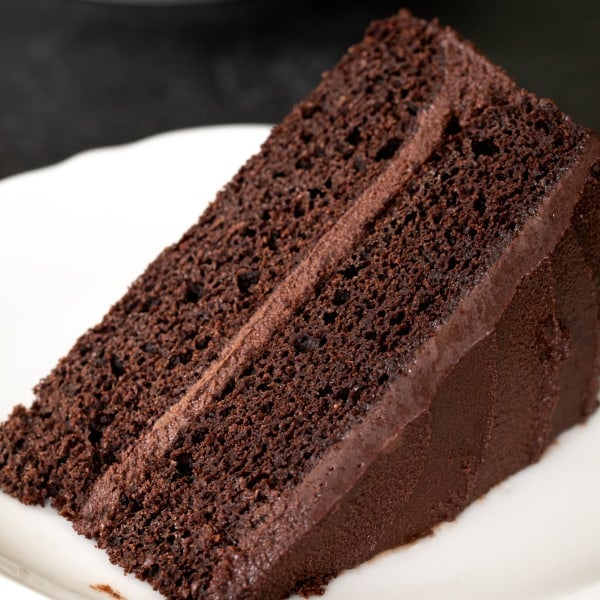

A moist and tender Paleo chocolate cake that's rich in chocolate flavor, but not too sweet. Layer it with a deep chocolate frosting, and let's celebrate!
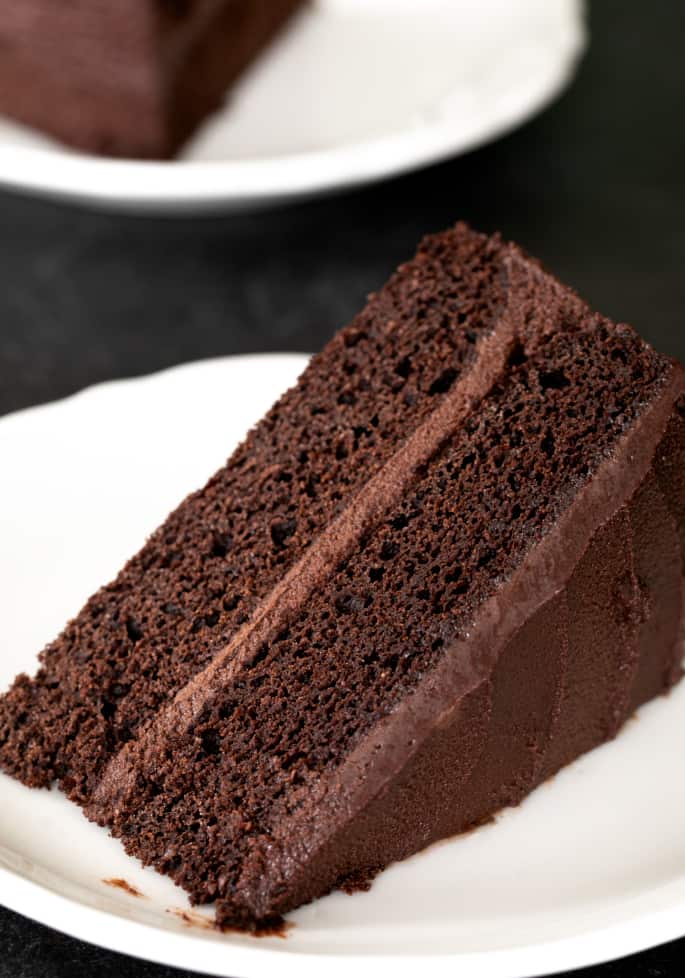
WANT TO SAVE THIS RECIPE?
A Paleo chocolate cake recipe with more accessible ingredients
This Paleo chocolate cake is made with coconut flour, which can be a very tricky ingredient to use in baking. It tends to create a very spongy texture since it's full of fiber and absorbs a ton of moisture.
But it can be done! Remember our coconut flour pancakes? They're made with a combination of coconut flour and tapioca starch/flour, just like this recipe.
As with the pancakes recipe, we've avoided an overload of eggs in this cake by adding that starch and by finding other sources of moisture.
No almond flour in this recipe
I really love baking with almond flour since it seems to mimic “regular flour” best (which for us means an all purpose gluten free flour like we use in our moist and tender, classic gluten free vanilla cake), especially when you pair it with a Paleo-friendly starch like arrowroot or tapioca/starch. But there are a few issues that always pop up whenever we bake with almond flour.
All of my almond flour recipes call for a high-quality, finely ground, blanched almond flour, like Honeyville brand or the finely ground almond flour from nuts.com. I have never found an almond flour that's available in a brick-and-mortar store that compares.
That means that baking with almond flour requires advance preparation. And sometimes you don't have a well-stocked Paleo pantry, but you still really (really) want to bake a cake when you find it. Coconut flour is available nearly everywhere—and I've never really detected a difference from one brand to another.
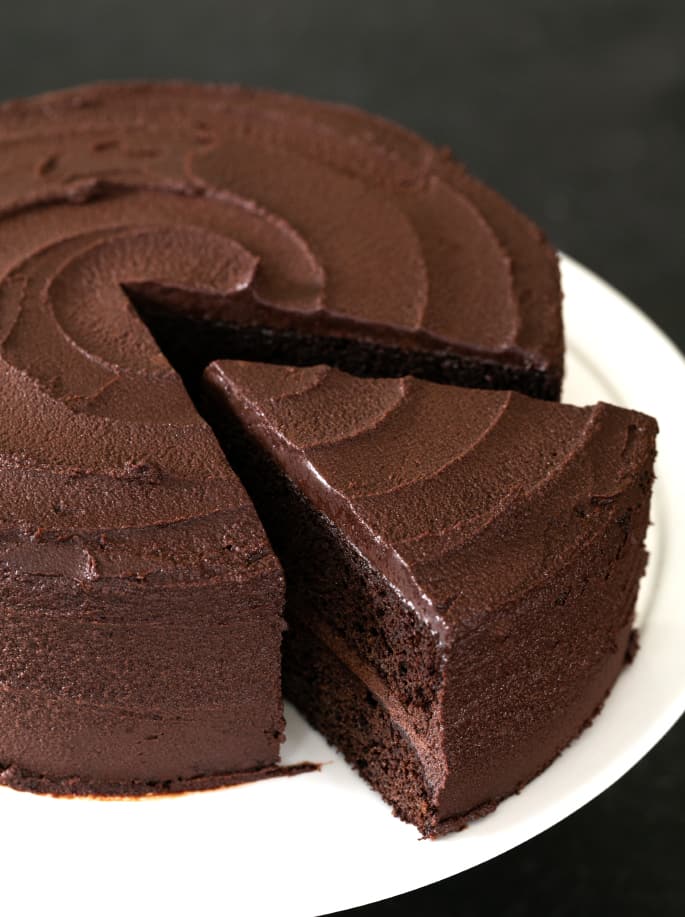
What about the starch?
True, this recipe does call for tapioca starch/flour, and a good-quality brand of that ingredient can also be hard to find. But you can replace that starch with arrowroot, if you have it.
Or honestly, you can even use a non-Paleo starch like cornstarch or potato starch if you really want to make this cake. Let's face it: there's plenty of honey in this recipe, and starch really is starch.
What about the baking powder?
Speaking of starch, this recipe does call for baking powder. Baking powder is a combination of baking soda, cream of tartar, and a starch. If your cake must be strictly Paleo-legal, reach for Paleo-friendly baking powder (they do sell them now!).
If not, just use the regular stuff. I won't tell. You could also make your own Paleo-friendly baking powder with 1 part baking soda, 2 parts cream of tartar and 1/2 part arrowroot or tapioca starch/flour.

Rich, chocolate frosting made with only 2 ingredients
Rather than try to make a buttercream frosting out of Paleo-friendly ingredients, I went with a simple Paleo chocolate ganache that I whipped into a spreadable frosting. Traditional ganache is made with chopped chocolate that's melted by pouring lightly simmering heavy whipping cream on top.
Here, we used coconut cream in place of heavy whipping cream. Just be sure you drain any liquid from the cream so the chopped chocolate doesn't seize. Once the mixture is melted and smooth, let it cool to room temperature and then chill until just set. Then, whip the mixture until it's fluffy and spreadable.
You could also use the rich ganache as a glaze by cooling it only slightly at room temperature. Then just pour it over the cakes. You could also whip half of the ganache and use it as a filling between the two cakes, then make the remaining half of the recipe and pour it over the top while it's still warm.

Paleo chocolate cake: ingredients & substitution suggestions
Since this is a Paleo chocolate cake recipe, by definition it is gluten-free and dairy-free, plus free of refined sugar. This is also a nut-free recipe, which is somewhat unusual for Paleo recipes, which typically rely heavily on almond flour.
If you've got some questions about other ingredients, here goes nothin':
Coconut flour: Coconut flour is a completely unique flour that has no equal. You cannot replace it with anything else, I'm afraid. It is the most important ingredient in this whole recipe.
Tapioca starch/flour: Tapioca starch and tapioca flour are the same thing, and the terms are used interchangeably. However, tapioca starch is not all created equal. The only brands I can recommend are those from nuts.com, Authentic Foods, and Vitacost.com.
If you would like to replace the tapioca starch/flour, you should be able to use arrowroot flour. In fact, the recipe from which this is adapted used arrowroot, so I'm sure it would work just fine.
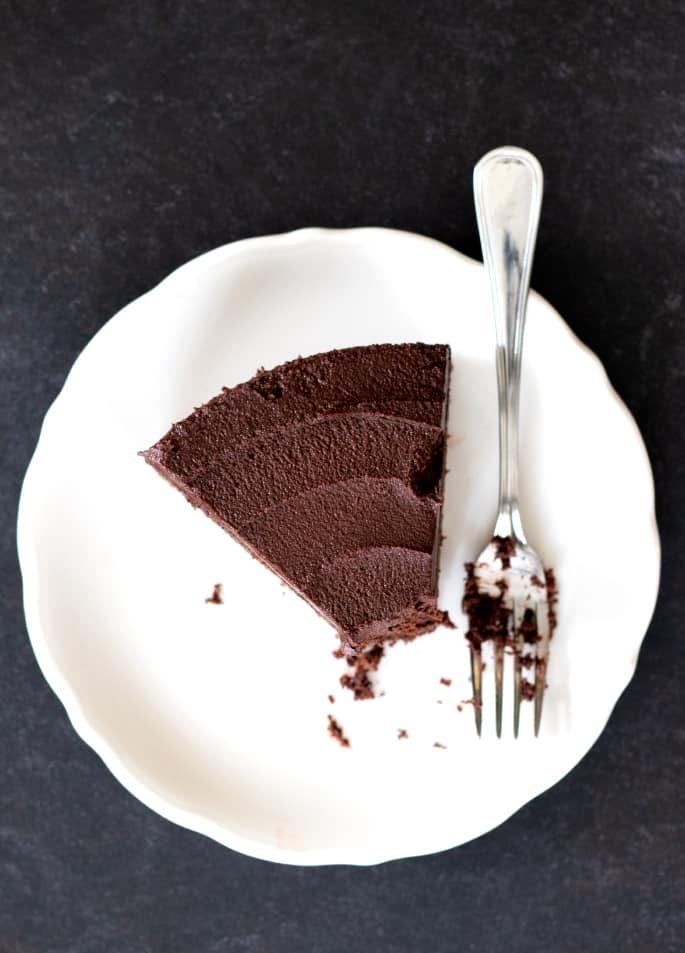
Eggs: There are 4 total eggs in this recipe. I'm afraid that's simply too many eggs to replace reliably. If you can't have eggs, I'd avoid this recipe. So sorry!
Cocoa powder: I really like Dutch-processed cocoa powder in this recipe, but natural cocoa powder should work just fine. You cannot replace the cocoa powder.
Coconut oil: The virgin coconut oil in this recipe should be able to replaced easily with Spectrum brand nonhydrogenated vegetable shortening. If you can have dairy, I bet unsalted butter would work just fine, too.
Coffee: You need a total of 2/3 cup (5 1/3 fluid ounces) liquid in this recipe. I like to use mostly strong brewed coffee, with a splash of unsweetened almond milk. But you can use all of one or all of the other.
If you use brewed coffee, the answer is no! The cake does not taste like coffee. The coffee just helps to deepen the chocolate flavor of the cake, and decaffeinated coffee is fine.
Honey: If you'd like to use another liquid sweetener, you'll need something that is as thick and rich as honey. Maple syrup is not an appropriate substitute for honey, I'm afraid.
Liquid Lankato monkfruit alternative sweetener might work. If you try it, let us know how it goes!
If you can, make the recipe just as written at least once, so you know exactly how it's meant to turn out. Then, you'll always know you can make a celebration cake for any occasion that everyone can enjoy!
Paleo Chocolate Cake
Ingredients
For the cakes
- 11 tablespoons (88 g) coconut flour
- 11 tablespoons (90 g) tapioca starch/flour
- ¼ teaspoon kosher salt
- 1 teaspoon baking powder (grain-free for very strict Paleo)
- 1 teaspoon baking soda
- ¾ cup (60 g) unsweetened cocoa powder (Dutch-processed is best, but natural is fine)
- 5 tablespoons (70 g) virgin coconut oil melted and cooled
- 10 tablespoons (210 g) honey
- 4 (200 g (weighed out of shell)) eggs at room temperature, beaten
- ⅔ cup (5 ⅓ fluid ounces) brewed strong coffee or unsweetened nondairy milk (or a combination)
For the frosting
- 12 ounces dark chocolate chopped fine
- 8 ounces coconut cream
Instructions
Make the cakes.
- Preheat your oven to 350°F.
- Grease and line two 8-inch round metal baking pans, and set them aside. The pans should be light in color, so the cakes don’t bake too quickly.
- In a large bowl, place the coconut flour, tapioca starch/flour, salt, baking powder, baking soda, and cocoa powder, and whisk to combine well.
- Add the oil, honey, eggs, and coffee and/or milk, and whisk until very smooth. The batter will be thickly pourable, and shouldn’t have any lumps.
- Divide the mixture evenly among the two prepared baking pans, tilting each pan to create an even layer of batter in it.
- Bang the bottom of each pan flat on the counter a few times to break any air bubbles.
- Place the pans in the preheated oven, and bake for 15 minutes.
- Rotate the pans in the oven and continue to bake for about another 7 minutes, or until the cakes spring back when pressed gently in the center. Do not overbake.
- Remove the cakes from the oven and place them, still in the pans, on a wire rack to cool for about 15 minutes.
- Remove the cakes from their pans, place them directly on the wire rack and allow them to cool completely.
Make the frosting.
- In a wide, flat, medium-sized and heat-safe bowl, place the chopped dark chocolate.
- Bring the coconut cream to a very gently simmer either in a pan over a low flame on the stovetop, or in the microwave in a heat-safe bowl.
- Pour the lightly simmering cream over the chopped chocolate and allow it to sit, undisturbed, for about 5 minutes before whisking until completely smooth.
- You can use the mixture to glaze the cakes as is, or allow it to set, then whip and use as frosting.
- To use the mixture as frosting, allow it sit until no longer warm to the touch, and then place in the refrigerator for about 20 minutes or until beginning to set.
- Using a handheld mixer or a stand mixer fitted with the whisk attachment, whip the frosting until lighter in color and relatively fluffy (about 3 minutes).
- Frost the cakes as desired, and then slice and serve.
WANT TO SAVE THIS RECIPE?

Thanks for stopping by!
Hi, I’m Nicole. I create gluten free recipes that really work and taste as good as you remember. No more making separate meals when someone is GF, or buying packaged foods that aren’t good enough to justify the price. At Gluten Free on a Shoestring, “good, for gluten free” just isn’t good enough! Come visit my bio!
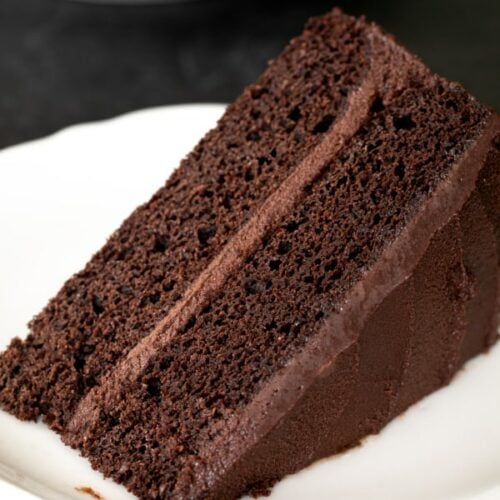


Elaine Schneider says
Could you substitute stevia for the honey? Do you make any recipes with stevia? My grandsons have Glycogen Storage Disease and can only have stevia as a sweetener which is almost impossible to use but to see their little faces watching everyone else at their deserts and during holidays watching everyone eat candy just breaks my heart. Any ideas?
Nicole Hunn says
Hi, Elaine, please see my response to your same question on the post for Flourless Peanut Butter Chocolate Chip Cookies.
Daphne says
Hi I cant wait to try this recipe. Just wondering what coconut cream is? I buy coconut milk but haven’t seen cream.
Nicole Hunn says
Hi, Daphne, coconut cream is just the solid stuff in a can of full-fat coconut milk. There is also coconut cream in a can, which has nearly no liquid. Either way, to separate the cream from the liquid, refrigerate the can so that the cream turns into a semi-solid state. Then, you can pour off the liquid and either use it for something else, or discard it.
Diana Hammons says
What kind of dark chocolate do you use in the frosting? What is it sweetened with?
Nicole Hunn says
Green & Blacks brand and Theo brand dark chocolates are Paleo-approved and seem to be pretty widely available, Diana!
Delphi Listener says
Made it today and everyone (even the non-keto family members) LOVED IT! I needed to substitute arrowroot for the tapioca flour (a vexing food sensibility for a gluten intolerant person). Made a ganache with Swerve. Added a couple fresh raspberries and mint leaves for garnish. Will absolutely make it again!
Nicole Hunn says
That sounds great all around! Thanks for letting us know what worked for you.
Liza says
This looks great although honey is not considered paleo but maple syrup is which probably could be easily substituted. I love baking with coconut flour so I look forward to trying this.
Nicole Hunn says
Honey is, indeed, Paleo-legal, Liza. Feel free to try something else, but I don’t recommend maple syrup since it’s much thinner and has a stronger flavor in baking.
Julie L says
This is a lovely recipe! Do you think I could freeze any leftover slices of cake? I don’t remember if I’ve successfully frozen coconut flour recipes or not.
Nicole Hunn says
If you’re sure you haven’t overbaked the cakes themselves (unfrosted), and then cool and wrap them very, very tightly, you can freeze the cakes. I’ve done it with good results. I hope that helps, Julie!
Burlene Brown says
When I use coconut flour, it is so gummy and tastes funny. Is that just my getting used to doing without real flour or am I doing something wrong. My almond flour recipes are grainy. What am I doing wrong?
Nicole Hunn says
I’m afraid I really can’t know how to advise you on others’ recipes. I’d go directly to the recipe developers themselves. But my Paleo recipes work and taste great, although you must follow instructions carefully for what flours to use (for ex, almond flour must be superfine blanched almond flour from one of my recommended sources), measure accurately by weight, etc.